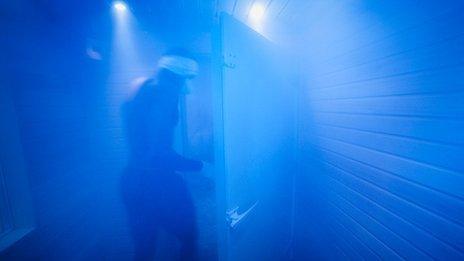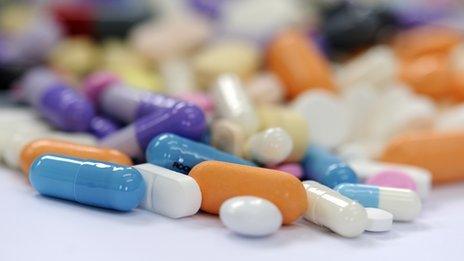How can an athlete enhance performance legally?
- Published

Cryotherapy chambers are increasing in popularity
What is the different between a gold and a silver medal? The enhancement of the performance by just 0.5% is what could keep an elite athlete away from glory.
In order to achieve maximum performance, an athlete can turn to a series of resources without crossing the line of illegality.
They are called performance, or ergogenic, aids and may include anything from good nutrition and a training plan to the consumption of supplements and legal substances.
There are also special gadgets that enhance athletes' lung capacity, improve transport of oxygen and speed up recovery.
Many of these techniques are widely accepted and are as simple as having a customised balanced diet or getting into a bath full of ice after exercise.
Others tend to invite more controversy and some specialists warn that they may be banned.
'Cocktail' of supplements
Every morning before breakfast, Fran Medina, 20 and a Spanish professional cyclist, takes a cocktail of multivitamins.
"I normally have folic acid, iron and vitamin C - that helps you to absorb all the vitamins."
He said he also takes vitamins B6 and B12, which he believes are good for "oxidative stress".
There is a theory that cells in the body experience molecular damage caused by reactive forms of oxygen, called free radicals. This is known as oxidative stress.
After two to four hours of training, Fran takes more supplements. These are a form of amino-acids which it has been suggested help rebuild muscles.
During the season, Fran also take L-arginine, which has been promoted as also being beneficial in tackling oxidative stress.
There are a wide variety of supplements on the market.

Multi-vitamins can be used by athletes
Dr Mikel Zabala, of the Sport Science Faculty at Granada University in Spain says: "It could be anything from bovine colostrum - because of its protein content- to caffeine, sodium bicarbonate and nicotine; although this last one has been under surveillance by the World Anti-doping Agency due to its activating effects."
He said that, while nicotine and caffeine help athlete to be more alert, other substances are used to build muscle strength.
One such supplement is creatine which, according to the magazine Nature, plays an important role in the production of energy in the body.
Beetroot juice is another common addition to the athlete's diet. It helps to increase the levels of nitric oxide in the body.
In the case of swimmers, for example, it could help them to reduce the number of breaths they take in a short distance competition.
Head in the clouds
One method that seems to be a current trend between professionals is so-called hypoxic training.
Athletes could be in a natural or artificial environment in which oxygen levels are reduced, forcing the cardio-respiratory system to work harder than normal.
"Hypoxic training is often used in endurance sports, when the transport of oxygen is highly important," Dr Zabala says.
If the training is in a natural environment, the athletes need to stay for several days in a high altitude training centre, while in an artificial environment this can be done at sea level with oxygen tents, where the athlete can sleep in a simulated environment of over 13,000 feet or perform intermittent exercise.
It has been revealed that Mo Farah slept in a oxygen tent up to the last day of his London 2012 Olympic event. The British MotoGP rider Cal Crutchlow uses it as well.
"There are athletes who spend between 12 and 14 hours a day in hypoxic," explains Dr Victoria Pons, from the nutritional department at the Centre of High Performance in Barcelona, Spain.
But she said: "Not everyone is going to benefit from it and experience an increase of haemoglobin and improvement in the transport of oxygen."
There have been suggestions that some high profile professional athletes are installing oxygen tents, costing up to US$5,000 (£3,087) in their homes.
However, Dr Pons recommends using them under professional supervision. "You cannot just get suddenly over 9,000 feet. It has to be done gradually. You have to watch out that you wake up fine, that you don't have a sleep disorder, headache or any other symptom that would be an indication that something is wrong."
Fran Medina hasn't tried oxygen tents, but he has spent periods at high altitude training centres.
"It is true that you don't experience an incredible increase of enhanced performance. However, when you are competing at the highest level, you do notice it. You notice that you have a plus when you most need it."
Artificial hypoxic training is not free from controversy; some countries have asked for it to be considered as form of doping, while it is banned in Italy.
Feeling the chill

Franck Ribery is believed to use cold saunas
If improving endurance is key for the athlete, so too is recovery. The athlete must recover from training quickly and safety before getting his or her body back to maximum strength.
For this purpose, exposure to cold temperature or cryotherapy usually works well to avoid problems of inflammation and bruising, and to accelerate the recovery process through vasoconstriction.
There are different methods: from putting ice into a bathtub to a cold sauna (sometimes called a Cryosauna) where the athlete exposes his body to temperatures as low as minus 180ºC and 200ºC.
"The reason this is good for performance is because anything that helps recovery will also help to be ready for the next day's training, and to have a better assimilation," says doctor Zabala.
Famous athletes such as Franck Ribéry or Cristiano Ronaldo are believed to have used cold saunas.
However, specialists recommend using it with caution. "You don't know how your brain is going to react or if your heart is sensitive to it", says Victoria Pons.
Cryosaunas cost around US$60,000 (£37,047).
Cyclist Fran Medina hasn't had a chance to use one. But in general he thinks that ergogenic aids are fundamental to enhance performance.
Would he survive without them for a season? "I would, but I'd probably have to put a lot more time into recovery, which means that I wouldn't be able to do more intensive training sessions. Everything would add up and in the end I believe my performance would be at 90%."
That's the difference between reaching the podium or being a runner up.
- Published5 June 2012
- Published7 January 2011